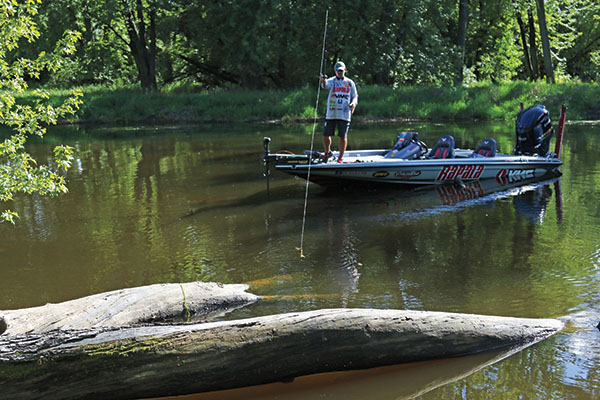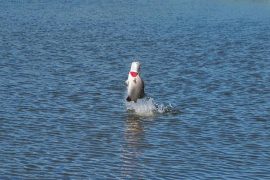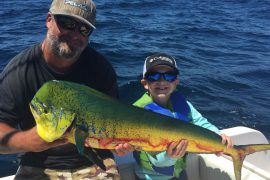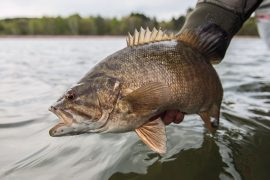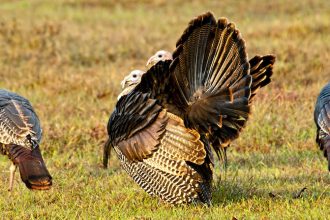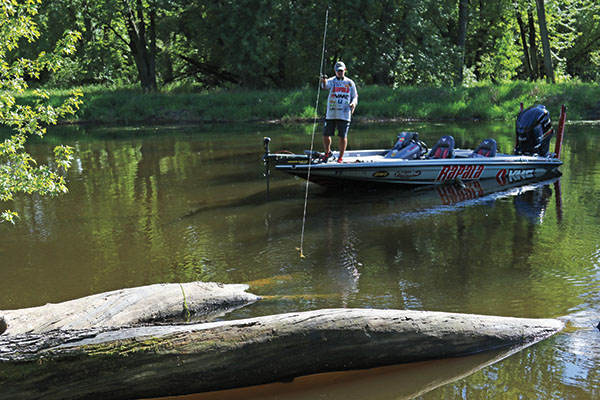
There’s no bad time to fish a bass jig, especially if you’re after big fish. Once largemouths move shallow in the Prespawn Period, they seek the best cover on the way toward shallow spawning flats and bays. Stumps and clumps of vegetation like lily pads and curly leaf pondweed attract fish as they feed before the spawn. Jigs score because, rigged right, they can combine power and finesse in one presentation. This package shows bass something that’s both vulnerable and worth chasing, from an energetic perspective.
Bass jigs remain a key lure for two reasons: versatility and the ability to make big bass bite. Today, the vast array of trailers increase further the versatility of jigs, as they can be used to bulk a presentation to resemble larger prey or to slow the fall rate. Slim trailers speed the fall and help a jig slide into tight holes in cover.
Late Prespawn Scenario
Anglers who follow the pro bass scene recognize the name Randall Tharp, as the former Alabama resident, now living in Florida, has built a strong reputation on both the FLW Tour and Bassmaser Elite scene. His reputation is based in large part on his skill with a jig.
“A 1/2-ounce jig is my confidence bait and I can go down a bank dropping it into vegetation and brush or skipping it under docks,” he says. Tharp helped design his signature jig for 4 X 4 Bass Jigs and he generally backs it with a Zoom Super Chunk, Jr., Super Chunk, or Big Salty Chunk, depending on conditons.
“Wherever I fish, I use that 4 X 4 jig,” Tharp says, “and I generally choose one of two colors—golden craw, which is green pumpkin with a bit of gold and black flake, or black-blue.
“I feel it’s important to limit your selection to some basics so you can focus your mind and your eyes on finding fish and making a careful and accurate presentation. That’s critical in jig fishing and you start the day with a lot of confidence.”
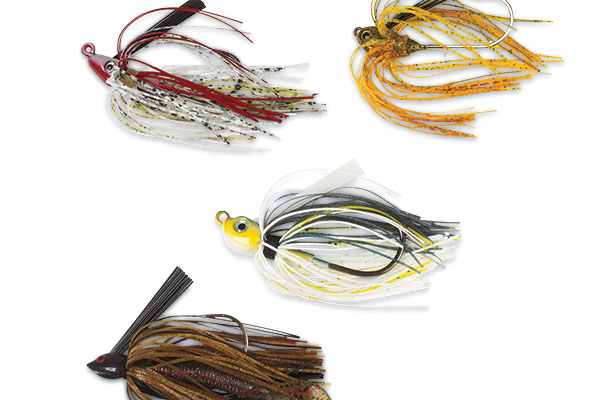
His formula was put to the test last spring when the Bassmaster Elite tour stopped at a pair of Ozark reservoirs where Tharp had never fished, Bull Shoals and Norfork in Arkansas. Following his own advice on jig tactics, he picked apart rocky banks and bulrush areas near channel swings, where the creek channel made a sharper turn, either along the bank or across a flat. “They’re great spring spots because bass have access to shallow and deep water in a small area, which is important when they’re getting ready to spawn,” he says. Pitching to cover less than 5 feet deep, he sacked over 60 pounds of bass to win the event, pocketing $103,000.
“The bass I was catching were mostly prespawn fish, feeding on shad and crayfish,” he adds. “But on the way back to the main lake after spawning, they might well use the same cover, as long as the water level is sufficient. I kept my boat in 8 to 12 feet of water and pitched the jig close to the bank, then worked it down the slope of the channel.
“It’s important to focus on how bass are biting a jig. On the afternoon of the second day of the event, I sensed that bass were becoming more aggressive, sometimes even following the jig as I pulled it in. I switched from a 1/2- to a 5/8-ounce jig to encourage that quick reaction bite. With that bit of added weight, it fell faster and I could work it faster along the bottom, But when I started with the heavier lure the next morning, they wouldn’t bite it. I had to go back to 1/2-ounce. These minor adjustments can make a big difference.”
The Summer Scene
On natural lakes and reservoirs with abundant vegetation, bass occupy various zones within this lush cover. Some great habitat is obvious, while other locales, typically deeper, are hidden from view. Sonar reveals these deeper edges, pockets, and points of vegetation where bass feed all summer long.
From Canada to California to Florida, bass favor tall emergent vegetation that carries many common names—bulrushes, reeds, buggy whips, and tules to name a few. These plants grow on a harder bottom that often limits submerged vegetation. But dense stands with pockets and points are key feeding areas for big bass throughout the season. They can be challenging to fish, and to pull big fish out of.
Casting, pitching, and flipping can all apply to bulrush fishing, depending on density of the plants and water depth. Active bass often move to the outer edges of stands or hold in open pockets where casting works. On the other hand, in the deepest, densest plots, you must proceed slowly and quietly, but you can catch fish within feet of the boat, with a near-vertical drop.
Vast vegetated flats are summer feeding grounds as well. For the highest-percentage fishing, focus on edges, particularly the deeper edge where vegetation tapers into the lake basin. In darker waters, this may occur in 6 to 8 feet of water, while in clear impoundments and lakes with hydrilla, edges may be out in 20 feet or even more. Active bass roam this outer edge throughout the day, but early in the morning, they often chase baitfish from open water toward the edge, which helps them trap their prey. As a school of shad or shiners approaches the weededge, it typically splits and smaller groups of baitfish scatter. When they do, bass attack, knowing they have an advantage over these small and swift swimmers.

Casting toward the edge with a weedless jig often takes the biggest fish of the day. Bass higher in the water column often eat the lure as it falls. At other times, you feel a thump and see the line jump within seconds of bottom contact. Note where the strikes come and you can adjust the presentation. If fish are biting on the fall, switch to a lighter jig to give more drop time. If they’re on bottom, go heavier to increase bottom thump and to get back down fast.
Building a Better Weed Jig
Jigs are deadly in grass. They can imitate a crayfish or a small baitfish such as a darter, sculpin, or small sunfish. Joe Medlock of Florida, a retired tool-and-die maker, had molded jigs since 1973 for himself and friends. Fishing in Florida’s luxuriant aquatic vegetation can be a challenge, whether it’s deep and dense hydrilla, rafts of floating hyacinths, fields of dollar pads, tall stands of clutching maindencane, or gnarly bulrushes more than 10 feet tall.
Dense stands of rushes present a special challenge, as a jig that tips sideways easily snags the stalks that…

